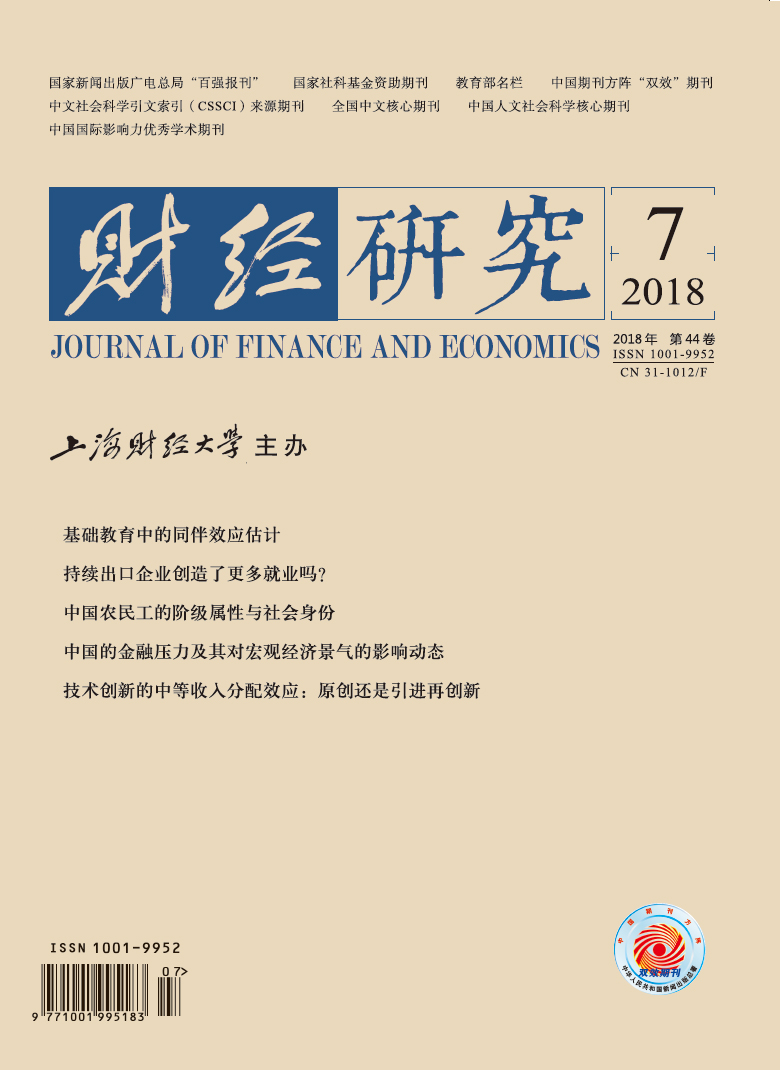对基础教育阶段不良同伴带来的短期和中长期效应的评估已经成为劳动经济学的热点话题。文章根据最新的2014年中国教育追踪调查(China Education Panel Survey,CEPS)微观数据,考察了不良同伴对学生标准化考试成绩的影响。为了克服反射(reflection)和自选择问题带来的估计偏误,文章依据班级上不良学生的比例而非传统文献采用的同伴成绩来刻画学生所处的班级环境,并控制了组群的自然特征。在控制学生个体特征和家庭因素后发现,学生所在班级中存在不良同伴,会对学生自身的学习成绩造成显著的负面影响,这一作用在高年级(初三)表现得尤为明显。班级不良同伴比例提高10%会带来平均成绩下降约2分。分样本的回归显示,男性学生、家庭经济状况不佳的学生和住校生的学习成绩对班级不良同伴的反应更敏感。而学校类型的异质性分析则表明,同伴效应在办学情况较差的学校和乡镇/农村学校表现得更明显。进一步的分位数回归结果表明,不良同伴产生的负面效应对成绩较差的学生影响更大。文章的研究发现有利于丰富学界对教育生产函数的认识,也为今后的教育政策提供有益参考。
基础教育中的同伴效应估计
摘要
参考文献
4 Aizer A. Peer effects and human capital accumulation: The externalities of ADD[R]. NBER Working Paper No. 14354, 2008.
5 Baldry A C. Bullying in schools and exposure to domestic violence[J]. Child Abuse & Neglect, 2003, 27(7): 713—732.
6 Bifulco R, Fletcher J M, Ross S L. The effect of classmate characteristics on post-secondary outcomes: Evidence from the add health[J]. American Economic Journal: Economic Policy, 2011, 3(1): 25—53. DOI:10.1257/pol.3.1.25
7 Black D S, Sussman S, Unger J B. A further look at the intergenerational transmission of violence: Witnessing interparental violence in emerging adulthood[J]. Journal of Interpersonal Violence, 2010, 25(6): 1022—1042. DOI:10.1177/0886260509340539
8 Bloom B. Human characteristics and school learning[M]. New York: McGraw-Hill, 1976.
9 Boozer M, Cacciola S E. Inside the ‘Black Box’ of project star: Estimation of peer effects using experimental data[R]. Yale Economic Growth Center Discussion Paper No. 832, 2001.
10 Bowles S. Towards an educational production function[A]. Hanson W L. Education, income, and human capital[C]. New York: Columbia University Press, 1970.
11 Buchinsky M. Changes in the U.S. wage structure 1963—1987: Application of quantile regression[J]. Econometrica, 1994, 62(2): 405—458. DOI:10.2307/2951618
12 Burke M A, Sass T R. Classroom peer effects and student achievement[J]. Journal of Labor Economics, 2013, 31(1): 51—82. DOI:10.1086/666653
14 Carrell S E, Malmstrom F V, West J E. Peer effects in academic cheating[J]. The Journal of Human Resources, 2008, 43(1): 173—207. DOI:10.3368/jhr.43.1.173
15 Carrell S E, Hoekstra M L. Externalities in the classroom: How children exposed to domestic violence affect everyone’s kids[J]. American Economic Journal: Applied Economics, 2010, 2(1): 211—228. DOI:10.1257/app.2.1.211
17 Carrell S E, Hoekstra M, Kuka E. The long-run effects of disruptive peers[R]. NBER Working Paper No. 22042, 2016.
18 Coleman J S. Equality of educational opportunity[M]. Washington: U.S. Dept. of Health, Education, and Welfare, Office of Education, 1966.
20 Edleson J L. Children’s witnessing of adult domestic violence.[J]. Journal of Interpersonal Violence, 1999, 14(8): 839—870. DOI:10.1177/088626099014008004
22 Foster G. It’s not your peers, and it’s not your friends: Some progress toward understanding the educational peer effect mechanism[J]. Journal of Public Economics, 2006, 90(8—9): 1455—1475. DOI:10.1016/j.jpubeco.2005.12.001
23 Hanushek E A, Kain J F, Markman J M, et al. Does peer ability affect student achievement? [J]. Journal of Applied Econometrics, 2003, 18(5): 527—544. DOI:10.1002/(ISSN)1099-1255
24 Hoxby C M. Peer effects in the classroom: Learning from gender and race variation[R]. NBER Working Paper No. 7867, 2000a.
25 Hoxby C M. The effects of class size on student achievement: New evidence from population variation[J]. The Quarterly Journal of Economics, 2000b, 115(4): 1239—1285. DOI:10.1162/003355300555060
26 Hoxby C M, Weingarth G. Taking race out of the equation: School reassignment and the structure of peer effects[R].Working Paper, 2005.
28 Kremer M, Dan L. Peer effects and alcohol use among college students[J]. Journal of Economic Perspectives, 2008, 22(3): 189—206. DOI:10.1257/jep.22.3.189
29 Lefgren L. Educational peer effects and the Chicago public schools[J]. Journal of Urban Economics, 2004, 56(2): 169—191. DOI:10.1016/j.jue.2004.03.010
30 Lyle D S. Estimating and interpreting peer and role model effects from randomly assigned social groups at west point[J]. Review of Economics and Statistics, 2007, 89(2): 289—299. DOI:10.1162/rest.89.2.289
31 Manski C F. Identification of endogenous social effects: The reflection problem[R]. Wisconsin Madison-Social Systems Working Paper, 1991.
33 Sacerdote B. Peer effects with random assignment: Results for Dartmouth roommates[J]. The Quarterly Journal of Economics, 2001, 116(2): 681—704. DOI:10.1162/00335530151144131
34 Stinebrickner R, Stinebrickner T R. What can be learned about peer effects using college roommates? Evidence from new survey data and students from disadvantaged backgrounds[J]. Journal of Public Economics, 2006, 90(8—9): 1435—1454. DOI:10.1016/j.jpubeco.2006.03.002
36 Zimmerman D J. Peer effects in academic outcomes: Evidence from a natural experiment[J]. Review of Economics and Statistics, 2003, 85(1): 9—23. DOI:10.1162/003465303762687677
引用本文
宗庆庆, 李雪松. 基础教育中的同伴效应估计[J]. 财经研究, 2018, 44(7): 4-15.
导出参考文献,格式为:
上一篇:房屋拆迁与家庭金融风险资产投资*





 6997
6997  9185
9185

